Financial Ratio Analysis: Ryanair, EasyJet, Flybe Comparison
VerifiedAdded on 2020/12/28
|12
|3487
|405
Report
AI Summary
This report presents a financial ratio analysis of Ryanair Holdings Public Limited, EasyJet Plc, and Flybe Group, examining their performance from 2016 to 2018. It delves into various financial and non-financial ratios, including current ratio, shareholders' liquidity ratio, gearing ratio, net asset turnove...

Accounting
pg. 1
pg. 1
Paraphrase This Document
Need a fresh take? Get an instant paraphrase of this document with our AI Paraphraser
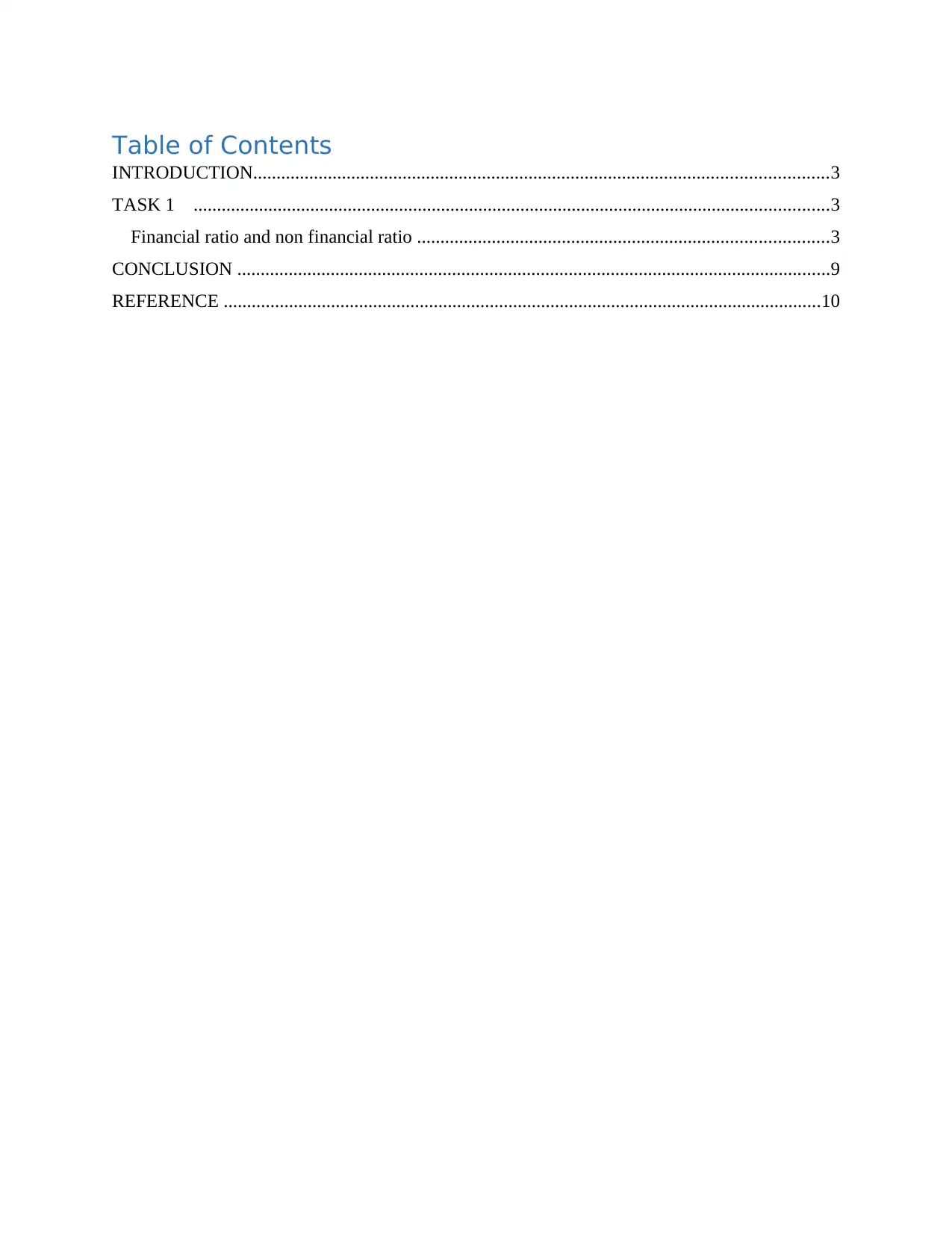
Table of Contents
INTRODUCTION...........................................................................................................................3
TASK 1 ........................................................................................................................................3
Financial ratio and non financial ratio ........................................................................................3
CONCLUSION ...............................................................................................................................9
REFERENCE ................................................................................................................................10
INTRODUCTION...........................................................................................................................3
TASK 1 ........................................................................................................................................3
Financial ratio and non financial ratio ........................................................................................3
CONCLUSION ...............................................................................................................................9
REFERENCE ................................................................................................................................10

INTRODUCTION
Accounting is the systematic and comprehensive recording of financial transaction
pertaining to a business. It is the process of summarizing, analysing & reporting the financial
translations. Financial statement are formal records of the financial activities & position of an
organisation and it involves balance sheet or statement of financial position. Financial statement
analysis is done so that financial position of company can be analysed. It allow the individuals to
examine its profit and loss account and it involves financial statements such as: balance sheet,
income statement etc. In this report there are three companies that have been chosen which are
Ryanair Holdings Public Limited, EasyJet Plc & Flybe group. The ratios has been calculated for
the three financial years and make comparison and on the basis of it investment decision can be
taken. Apart from this it also discuss about to develop a memo on investment appraisal which is
helpful in decision making process.
TASK 1
Financial ratio and non financial ratio
Financial ratios: These are the key indicators of financial performance of organisation
which are derived by three financial statement such as: balance sheet, cash flow and income
statement. It is helpful to consider liquidity, profitability and financial stability (Financial ratios.
, 2019).
Financial ratios are very effective accounting tool which is beneficial for the organisation
as well as for the shareholders and investors so that they can evaluate & compare relationships
among distinct pieces of information in context to the business and operations of company.
While calculating the financial ratios a person can take help from the balance sheet, income
statement and cash flow. It is helpful to develop the insights about the financial position of
corporation. As ratios are helpful to analyse the liquidity,efficiency, profitability of a company
and it is helpful to analyse the financial performance and its position. The information has been
taken from the financial statements. Non financial ratios involves product return ratio which
describes the rate at which a specific product is returned as faulty. Business plan KPI's ratio
shows the rate at which a key performance indicator is associated with a specific department for
a specific product. As the staff turn over ratio is a non-financial ratio (Loughran and McDonald,
2016).
3
Accounting is the systematic and comprehensive recording of financial transaction
pertaining to a business. It is the process of summarizing, analysing & reporting the financial
translations. Financial statement are formal records of the financial activities & position of an
organisation and it involves balance sheet or statement of financial position. Financial statement
analysis is done so that financial position of company can be analysed. It allow the individuals to
examine its profit and loss account and it involves financial statements such as: balance sheet,
income statement etc. In this report there are three companies that have been chosen which are
Ryanair Holdings Public Limited, EasyJet Plc & Flybe group. The ratios has been calculated for
the three financial years and make comparison and on the basis of it investment decision can be
taken. Apart from this it also discuss about to develop a memo on investment appraisal which is
helpful in decision making process.
TASK 1
Financial ratio and non financial ratio
Financial ratios: These are the key indicators of financial performance of organisation
which are derived by three financial statement such as: balance sheet, cash flow and income
statement. It is helpful to consider liquidity, profitability and financial stability (Financial ratios.
, 2019).
Financial ratios are very effective accounting tool which is beneficial for the organisation
as well as for the shareholders and investors so that they can evaluate & compare relationships
among distinct pieces of information in context to the business and operations of company.
While calculating the financial ratios a person can take help from the balance sheet, income
statement and cash flow. It is helpful to develop the insights about the financial position of
corporation. As ratios are helpful to analyse the liquidity,efficiency, profitability of a company
and it is helpful to analyse the financial performance and its position. The information has been
taken from the financial statements. Non financial ratios involves product return ratio which
describes the rate at which a specific product is returned as faulty. Business plan KPI's ratio
shows the rate at which a key performance indicator is associated with a specific department for
a specific product. As the staff turn over ratio is a non-financial ratio (Loughran and McDonald,
2016).
3
⊘ This is a preview!⊘
Do you want full access?
Subscribe today to unlock all pages.

Trusted by 1+ million students worldwide

Current ratio: It is the part of financial ratio and it is calculated to know the liquidity of
an organisation that how much it is able to pay off its debts in context to financial obligations.
An ideal current ratio is require to be 2:1 and it provide help the investors to make its investment
decisions. If current ratio is decreasing than it is not good for the company because corporation
does not have assets to meet the liabilities. To analyse the liquidity of organisation current ratio
has been selected. The formula of current ratio is current assets / current liabilities.
Ryanair Holdings Public Limited Company: As from the financial statements of
company it has been analysed that form the year 2016 to 2018 the current ratio is reducing and it
becomes 1.43 to 1.23 and it is not good for the organisation (Ryanair Holdings Public Limited.
2018).
Flybe Group Plc: As from the financial statement it has been analysed that current ratio
of company is getting down from the year 2016 to 2018 and it becomes 1.06 to 0.71 and it shows
the liquidity of this organisation is not good.
EasyJet Plc: As from the financial statement of company it has been analysed that current
ratio is continuously increasing from the year 2016 to 2018 and becomes 0.72 to 1.04. It shows
that company can pay off its financial obligations.
Shareholders liquidity ratio: This specific ratio has reflects as percentage reason being
there are dividing total shareholder's equity by total assets of the company. This ratio has been
chosen reason being it shows how much of an organisation's assets are being funded by equity
shares (McNichols and Stubben, 2015).
Ryanair holdings public limited company: As from the financial statements it has been reflected
that shareholders liquidity ratio is increasing which is 0.85 to 1 from the year 2016 to 2018 and it
shows that company can pay the amounts to their shareholders.
Flybe group plc: From the year 2016 to 2018 it is reducing and becomes 1.03 to 0.38 and
it shows that company cannot pay the amounts to its shareholders.
EasyJet plc: In the year 2016 to 2018 this ratio is reducing and becomes 2.77 to 1.87
which reflects that organisation is not in the situation to pay the amounts to their shareholders.
4
an organisation that how much it is able to pay off its debts in context to financial obligations.
An ideal current ratio is require to be 2:1 and it provide help the investors to make its investment
decisions. If current ratio is decreasing than it is not good for the company because corporation
does not have assets to meet the liabilities. To analyse the liquidity of organisation current ratio
has been selected. The formula of current ratio is current assets / current liabilities.
Ryanair Holdings Public Limited Company: As from the financial statements of
company it has been analysed that form the year 2016 to 2018 the current ratio is reducing and it
becomes 1.43 to 1.23 and it is not good for the organisation (Ryanair Holdings Public Limited.
2018).
Flybe Group Plc: As from the financial statement it has been analysed that current ratio
of company is getting down from the year 2016 to 2018 and it becomes 1.06 to 0.71 and it shows
the liquidity of this organisation is not good.
EasyJet Plc: As from the financial statement of company it has been analysed that current
ratio is continuously increasing from the year 2016 to 2018 and becomes 0.72 to 1.04. It shows
that company can pay off its financial obligations.
Shareholders liquidity ratio: This specific ratio has reflects as percentage reason being
there are dividing total shareholder's equity by total assets of the company. This ratio has been
chosen reason being it shows how much of an organisation's assets are being funded by equity
shares (McNichols and Stubben, 2015).
Ryanair holdings public limited company: As from the financial statements it has been reflected
that shareholders liquidity ratio is increasing which is 0.85 to 1 from the year 2016 to 2018 and it
shows that company can pay the amounts to their shareholders.
Flybe group plc: From the year 2016 to 2018 it is reducing and becomes 1.03 to 0.38 and
it shows that company cannot pay the amounts to its shareholders.
EasyJet plc: In the year 2016 to 2018 this ratio is reducing and becomes 2.77 to 1.87
which reflects that organisation is not in the situation to pay the amounts to their shareholders.
4
Paraphrase This Document
Need a fresh take? Get an instant paraphrase of this document with our AI Paraphraser

Gearing Ratio: This ratio emphasis on capital structure of organisation which shows the
portion of finance which is provided by debt relative to the finance provided by equity. This ratio
is selected because it shoes the liquidity of business.
Flybe group plc: This ratio is increasing from the year 2016 to 2018 and it becomes
106.62 to 281.20. It is good for the company to pay off its debts.
Ryanair holdings public limited company: As from the financial statements it has been
analysed that from the year 2016 to 2018 this ratio is continuously reducing which is 130.73 to
109.97 which shows that organisation does not paying debts (Smith, 2017).
EasyJet plc: Tt has been analysed that from the year 2016 to 2018 this ratio is
continuously reducing which is 39.97 to 53.50 and it is not good for the organisation and it
reflects that company does not paying debts (EasyJet Plc, 2018).
Net assets turn over ratio: This ratio has been chosen because it analyse the
organisation ability to generate sales from the assets by making comparison to the net sales with
average total sales. If it is more than it is good for the company because the assets of
organisation is able to increase sales.
EasyJet plc: The financial statements of company shows that this ratio is reducing from
the year 2016 to 2018 and it becomes 1.53 to 1.17 which is not good for the organisation.
Ryanair holdings public limited company: According to the financial statement of
company it has been analysed that this ratio is decreasing from the year 2016 to 2018 and it is
0.83 to 0.80 which shows that assets of company does not able bring sales.
Flybe group plc: It has been analysed that from the year 2016 to 2018 this ratio has been
reduced which is 2.08 to 2.25 and it is not good for the company.
Net Profit margin ratio: This ratio has been selected by the companies to analyse the
percentage of profits a corporation produces from its total revenue. If this ratio is increasing than
It is shows that company is earning profits and its financial performance is good (Griffin and
Wright, 2015).
EasyJet plc: This ratio is reducing from the year 2016 to 2018 and it is 14.62 to 7.63
which shows that net profit margin is decreasing and it is not good for the organisation.
5
portion of finance which is provided by debt relative to the finance provided by equity. This ratio
is selected because it shoes the liquidity of business.
Flybe group plc: This ratio is increasing from the year 2016 to 2018 and it becomes
106.62 to 281.20. It is good for the company to pay off its debts.
Ryanair holdings public limited company: As from the financial statements it has been
analysed that from the year 2016 to 2018 this ratio is continuously reducing which is 130.73 to
109.97 which shows that organisation does not paying debts (Smith, 2017).
EasyJet plc: Tt has been analysed that from the year 2016 to 2018 this ratio is
continuously reducing which is 39.97 to 53.50 and it is not good for the organisation and it
reflects that company does not paying debts (EasyJet Plc, 2018).
Net assets turn over ratio: This ratio has been chosen because it analyse the
organisation ability to generate sales from the assets by making comparison to the net sales with
average total sales. If it is more than it is good for the company because the assets of
organisation is able to increase sales.
EasyJet plc: The financial statements of company shows that this ratio is reducing from
the year 2016 to 2018 and it becomes 1.53 to 1.17 which is not good for the organisation.
Ryanair holdings public limited company: According to the financial statement of
company it has been analysed that this ratio is decreasing from the year 2016 to 2018 and it is
0.83 to 0.80 which shows that assets of company does not able bring sales.
Flybe group plc: It has been analysed that from the year 2016 to 2018 this ratio has been
reduced which is 2.08 to 2.25 and it is not good for the company.
Net Profit margin ratio: This ratio has been selected by the companies to analyse the
percentage of profits a corporation produces from its total revenue. If this ratio is increasing than
It is shows that company is earning profits and its financial performance is good (Griffin and
Wright, 2015).
EasyJet plc: This ratio is reducing from the year 2016 to 2018 and it is 14.62 to 7.63
which shows that net profit margin is decreasing and it is not good for the organisation.
5
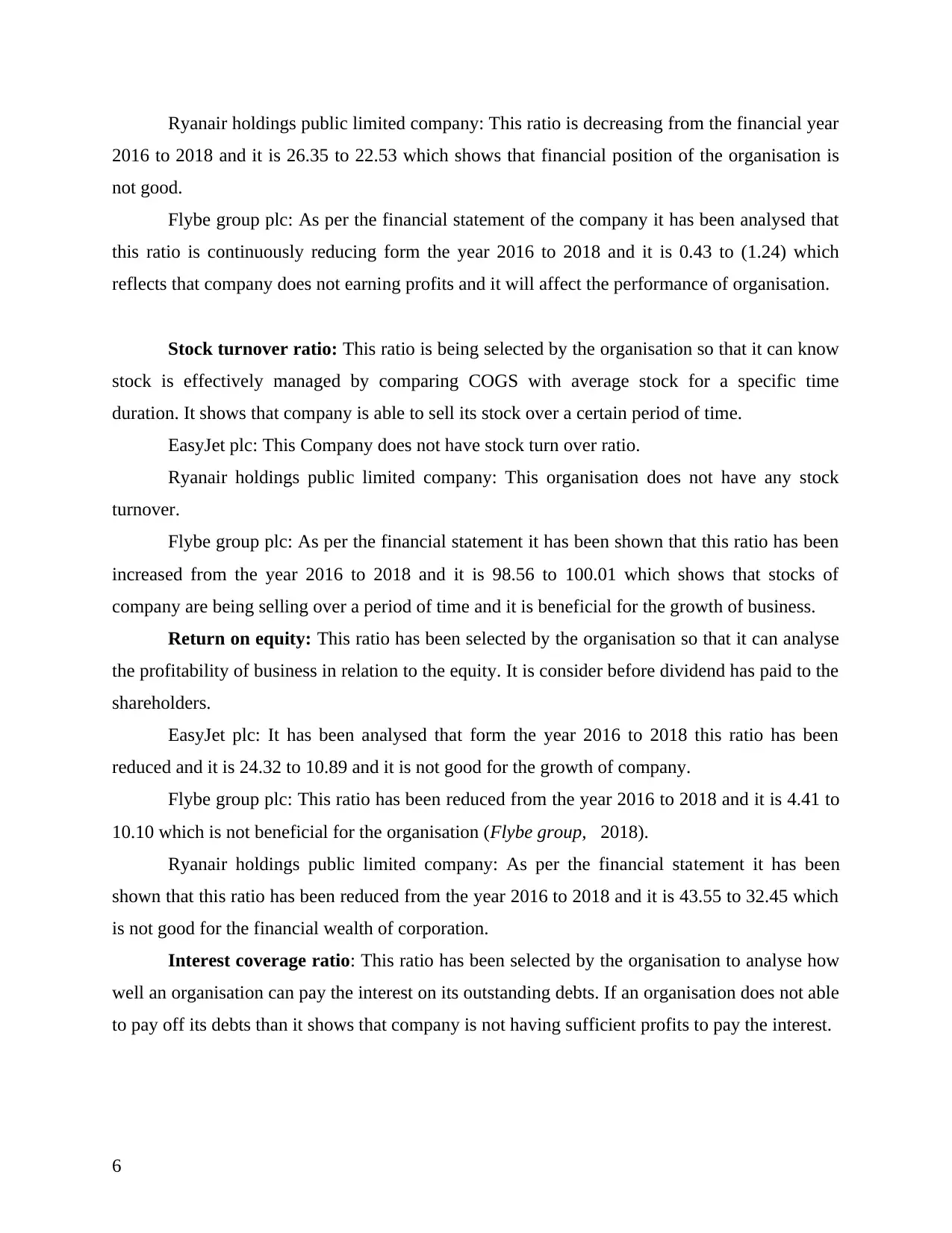
Ryanair holdings public limited company: This ratio is decreasing from the financial year
2016 to 2018 and it is 26.35 to 22.53 which shows that financial position of the organisation is
not good.
Flybe group plc: As per the financial statement of the company it has been analysed that
this ratio is continuously reducing form the year 2016 to 2018 and it is 0.43 to (1.24) which
reflects that company does not earning profits and it will affect the performance of organisation.
Stock turnover ratio: This ratio is being selected by the organisation so that it can know
stock is effectively managed by comparing COGS with average stock for a specific time
duration. It shows that company is able to sell its stock over a certain period of time.
EasyJet plc: This Company does not have stock turn over ratio.
Ryanair holdings public limited company: This organisation does not have any stock
turnover.
Flybe group plc: As per the financial statement it has been shown that this ratio has been
increased from the year 2016 to 2018 and it is 98.56 to 100.01 which shows that stocks of
company are being selling over a period of time and it is beneficial for the growth of business.
Return on equity: This ratio has been selected by the organisation so that it can analyse
the profitability of business in relation to the equity. It is consider before dividend has paid to the
shareholders.
EasyJet plc: It has been analysed that form the year 2016 to 2018 this ratio has been
reduced and it is 24.32 to 10.89 and it is not good for the growth of company.
Flybe group plc: This ratio has been reduced from the year 2016 to 2018 and it is 4.41 to
10.10 which is not beneficial for the organisation (Flybe group, 2018).
Ryanair holdings public limited company: As per the financial statement it has been
shown that this ratio has been reduced from the year 2016 to 2018 and it is 43.55 to 32.45 which
is not good for the financial wealth of corporation.
Interest coverage ratio: This ratio has been selected by the organisation to analyse how
well an organisation can pay the interest on its outstanding debts. If an organisation does not able
to pay off its debts than it shows that company is not having sufficient profits to pay the interest.
6
2016 to 2018 and it is 26.35 to 22.53 which shows that financial position of the organisation is
not good.
Flybe group plc: As per the financial statement of the company it has been analysed that
this ratio is continuously reducing form the year 2016 to 2018 and it is 0.43 to (1.24) which
reflects that company does not earning profits and it will affect the performance of organisation.
Stock turnover ratio: This ratio is being selected by the organisation so that it can know
stock is effectively managed by comparing COGS with average stock for a specific time
duration. It shows that company is able to sell its stock over a certain period of time.
EasyJet plc: This Company does not have stock turn over ratio.
Ryanair holdings public limited company: This organisation does not have any stock
turnover.
Flybe group plc: As per the financial statement it has been shown that this ratio has been
increased from the year 2016 to 2018 and it is 98.56 to 100.01 which shows that stocks of
company are being selling over a period of time and it is beneficial for the growth of business.
Return on equity: This ratio has been selected by the organisation so that it can analyse
the profitability of business in relation to the equity. It is consider before dividend has paid to the
shareholders.
EasyJet plc: It has been analysed that form the year 2016 to 2018 this ratio has been
reduced and it is 24.32 to 10.89 and it is not good for the growth of company.
Flybe group plc: This ratio has been reduced from the year 2016 to 2018 and it is 4.41 to
10.10 which is not beneficial for the organisation (Flybe group, 2018).
Ryanair holdings public limited company: As per the financial statement it has been
shown that this ratio has been reduced from the year 2016 to 2018 and it is 43.55 to 32.45 which
is not good for the financial wealth of corporation.
Interest coverage ratio: This ratio has been selected by the organisation to analyse how
well an organisation can pay the interest on its outstanding debts. If an organisation does not able
to pay off its debts than it shows that company is not having sufficient profits to pay the interest.
6
⊘ This is a preview!⊘
Do you want full access?
Subscribe today to unlock all pages.

Trusted by 1+ million students worldwide
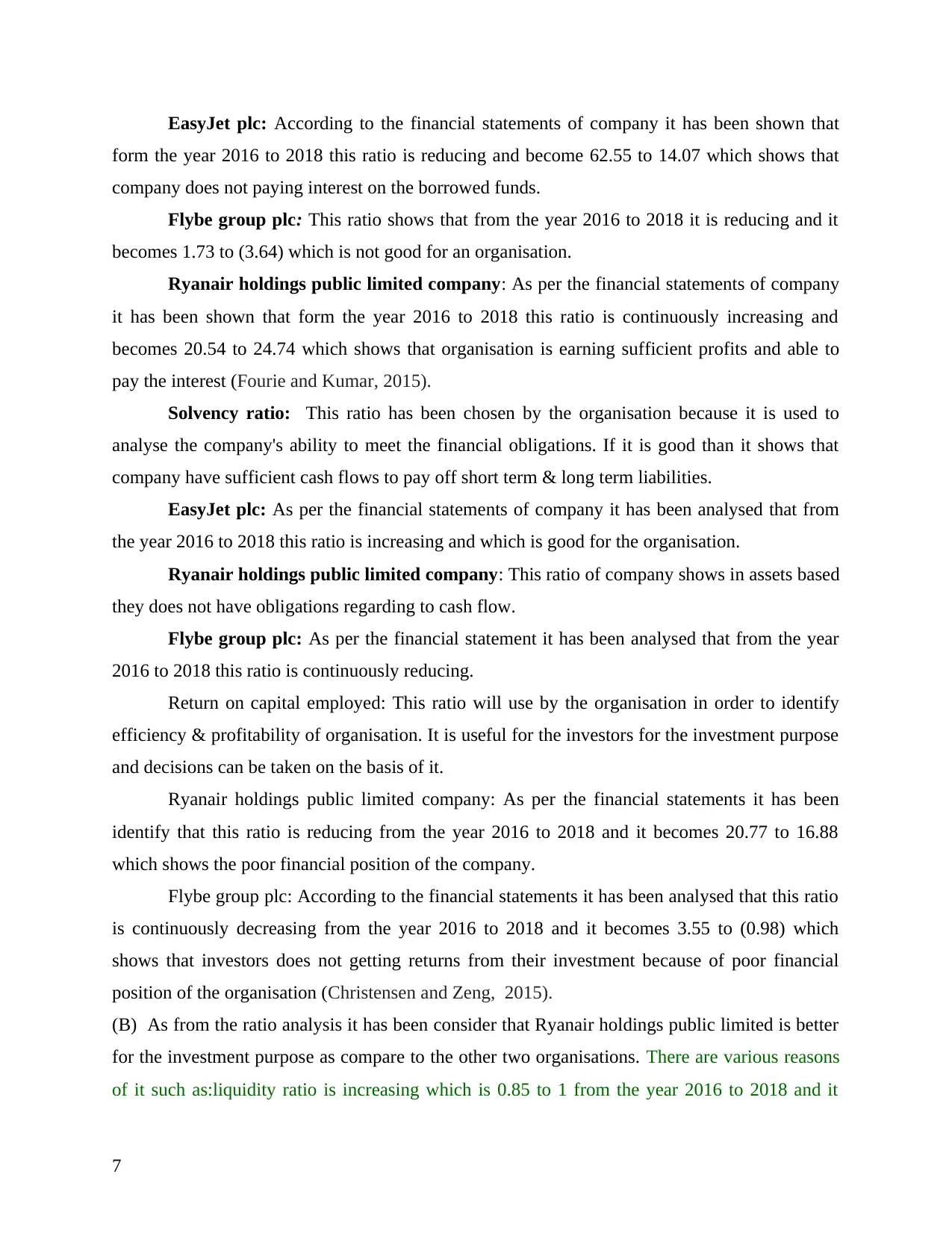
EasyJet plc: According to the financial statements of company it has been shown that
form the year 2016 to 2018 this ratio is reducing and become 62.55 to 14.07 which shows that
company does not paying interest on the borrowed funds.
Flybe group plc: This ratio shows that from the year 2016 to 2018 it is reducing and it
becomes 1.73 to (3.64) which is not good for an organisation.
Ryanair holdings public limited company: As per the financial statements of company
it has been shown that form the year 2016 to 2018 this ratio is continuously increasing and
becomes 20.54 to 24.74 which shows that organisation is earning sufficient profits and able to
pay the interest (Fourie and Kumar, 2015).
Solvency ratio: This ratio has been chosen by the organisation because it is used to
analyse the company's ability to meet the financial obligations. If it is good than it shows that
company have sufficient cash flows to pay off short term & long term liabilities.
EasyJet plc: As per the financial statements of company it has been analysed that from
the year 2016 to 2018 this ratio is increasing and which is good for the organisation.
Ryanair holdings public limited company: This ratio of company shows in assets based
they does not have obligations regarding to cash flow.
Flybe group plc: As per the financial statement it has been analysed that from the year
2016 to 2018 this ratio is continuously reducing.
Return on capital employed: This ratio will use by the organisation in order to identify
efficiency & profitability of organisation. It is useful for the investors for the investment purpose
and decisions can be taken on the basis of it.
Ryanair holdings public limited company: As per the financial statements it has been
identify that this ratio is reducing from the year 2016 to 2018 and it becomes 20.77 to 16.88
which shows the poor financial position of the company.
Flybe group plc: According to the financial statements it has been analysed that this ratio
is continuously decreasing from the year 2016 to 2018 and it becomes 3.55 to (0.98) which
shows that investors does not getting returns from their investment because of poor financial
position of the organisation (Christensen and Zeng, 2015).
(B) As from the ratio analysis it has been consider that Ryanair holdings public limited is better
for the investment purpose as compare to the other two organisations. There are various reasons
of it such as:liquidity ratio is increasing which is 0.85 to 1 from the year 2016 to 2018 and it
7
form the year 2016 to 2018 this ratio is reducing and become 62.55 to 14.07 which shows that
company does not paying interest on the borrowed funds.
Flybe group plc: This ratio shows that from the year 2016 to 2018 it is reducing and it
becomes 1.73 to (3.64) which is not good for an organisation.
Ryanair holdings public limited company: As per the financial statements of company
it has been shown that form the year 2016 to 2018 this ratio is continuously increasing and
becomes 20.54 to 24.74 which shows that organisation is earning sufficient profits and able to
pay the interest (Fourie and Kumar, 2015).
Solvency ratio: This ratio has been chosen by the organisation because it is used to
analyse the company's ability to meet the financial obligations. If it is good than it shows that
company have sufficient cash flows to pay off short term & long term liabilities.
EasyJet plc: As per the financial statements of company it has been analysed that from
the year 2016 to 2018 this ratio is increasing and which is good for the organisation.
Ryanair holdings public limited company: This ratio of company shows in assets based
they does not have obligations regarding to cash flow.
Flybe group plc: As per the financial statement it has been analysed that from the year
2016 to 2018 this ratio is continuously reducing.
Return on capital employed: This ratio will use by the organisation in order to identify
efficiency & profitability of organisation. It is useful for the investors for the investment purpose
and decisions can be taken on the basis of it.
Ryanair holdings public limited company: As per the financial statements it has been
identify that this ratio is reducing from the year 2016 to 2018 and it becomes 20.77 to 16.88
which shows the poor financial position of the company.
Flybe group plc: According to the financial statements it has been analysed that this ratio
is continuously decreasing from the year 2016 to 2018 and it becomes 3.55 to (0.98) which
shows that investors does not getting returns from their investment because of poor financial
position of the organisation (Christensen and Zeng, 2015).
(B) As from the ratio analysis it has been consider that Ryanair holdings public limited is better
for the investment purpose as compare to the other two organisations. There are various reasons
of it such as:liquidity ratio is increasing which is 0.85 to 1 from the year 2016 to 2018 and it
7
Paraphrase This Document
Need a fresh take? Get an instant paraphrase of this document with our AI Paraphraser
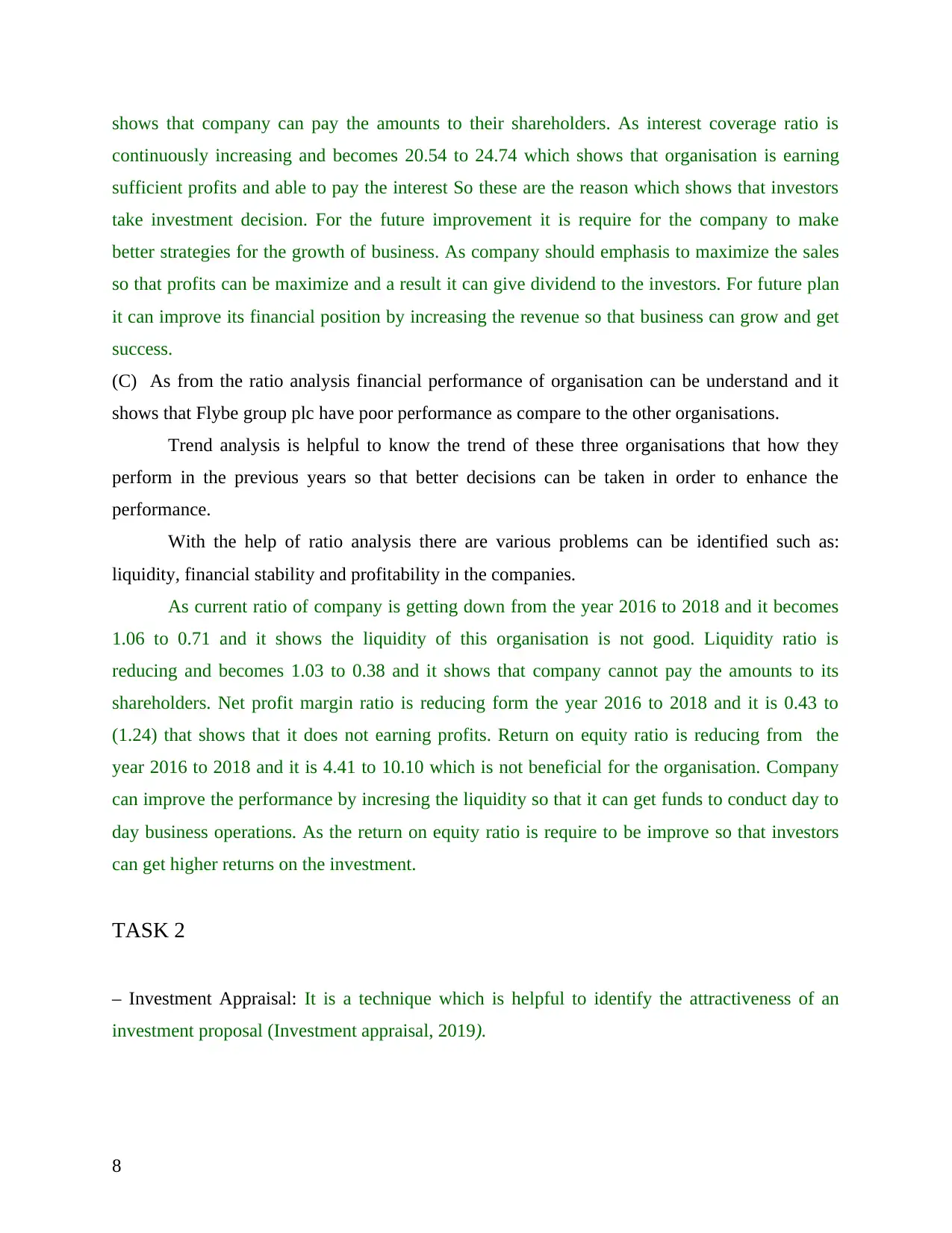
shows that company can pay the amounts to their shareholders. As interest coverage ratio is
continuously increasing and becomes 20.54 to 24.74 which shows that organisation is earning
sufficient profits and able to pay the interest So these are the reason which shows that investors
take investment decision. For the future improvement it is require for the company to make
better strategies for the growth of business. As company should emphasis to maximize the sales
so that profits can be maximize and a result it can give dividend to the investors. For future plan
it can improve its financial position by increasing the revenue so that business can grow and get
success.
(C) As from the ratio analysis financial performance of organisation can be understand and it
shows that Flybe group plc have poor performance as compare to the other organisations.
Trend analysis is helpful to know the trend of these three organisations that how they
perform in the previous years so that better decisions can be taken in order to enhance the
performance.
With the help of ratio analysis there are various problems can be identified such as:
liquidity, financial stability and profitability in the companies.
As current ratio of company is getting down from the year 2016 to 2018 and it becomes
1.06 to 0.71 and it shows the liquidity of this organisation is not good. Liquidity ratio is
reducing and becomes 1.03 to 0.38 and it shows that company cannot pay the amounts to its
shareholders. Net profit margin ratio is reducing form the year 2016 to 2018 and it is 0.43 to
(1.24) that shows that it does not earning profits. Return on equity ratio is reducing from the
year 2016 to 2018 and it is 4.41 to 10.10 which is not beneficial for the organisation. Company
can improve the performance by incresing the liquidity so that it can get funds to conduct day to
day business operations. As the return on equity ratio is require to be improve so that investors
can get higher returns on the investment.
TASK 2
– Investment Appraisal: It is a technique which is helpful to identify the attractiveness of an
investment proposal (Investment appraisal, 2019).
8
continuously increasing and becomes 20.54 to 24.74 which shows that organisation is earning
sufficient profits and able to pay the interest So these are the reason which shows that investors
take investment decision. For the future improvement it is require for the company to make
better strategies for the growth of business. As company should emphasis to maximize the sales
so that profits can be maximize and a result it can give dividend to the investors. For future plan
it can improve its financial position by increasing the revenue so that business can grow and get
success.
(C) As from the ratio analysis financial performance of organisation can be understand and it
shows that Flybe group plc have poor performance as compare to the other organisations.
Trend analysis is helpful to know the trend of these three organisations that how they
perform in the previous years so that better decisions can be taken in order to enhance the
performance.
With the help of ratio analysis there are various problems can be identified such as:
liquidity, financial stability and profitability in the companies.
As current ratio of company is getting down from the year 2016 to 2018 and it becomes
1.06 to 0.71 and it shows the liquidity of this organisation is not good. Liquidity ratio is
reducing and becomes 1.03 to 0.38 and it shows that company cannot pay the amounts to its
shareholders. Net profit margin ratio is reducing form the year 2016 to 2018 and it is 0.43 to
(1.24) that shows that it does not earning profits. Return on equity ratio is reducing from the
year 2016 to 2018 and it is 4.41 to 10.10 which is not beneficial for the organisation. Company
can improve the performance by incresing the liquidity so that it can get funds to conduct day to
day business operations. As the return on equity ratio is require to be improve so that investors
can get higher returns on the investment.
TASK 2
– Investment Appraisal: It is a technique which is helpful to identify the attractiveness of an
investment proposal (Investment appraisal, 2019).
8
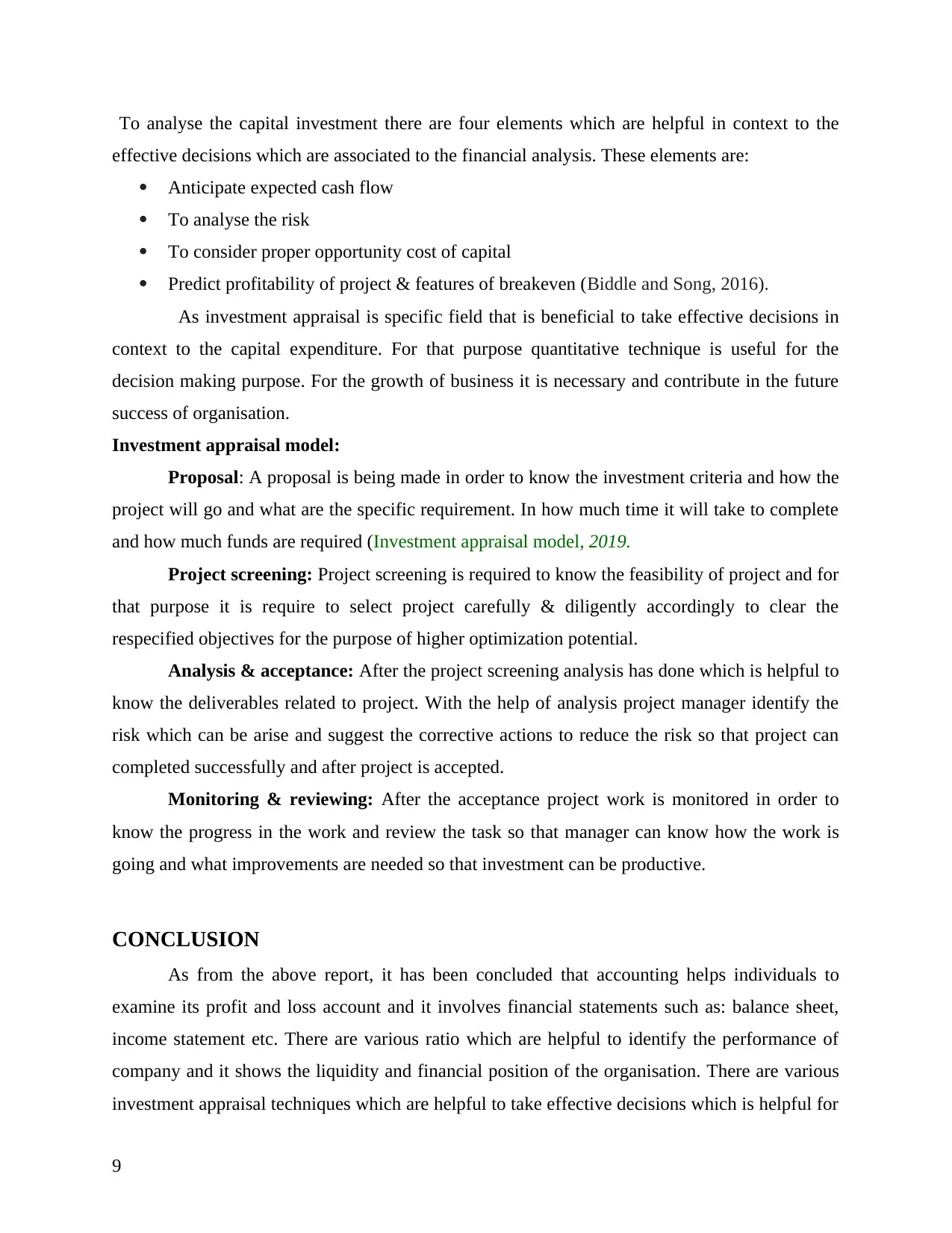
To analyse the capital investment there are four elements which are helpful in context to the
effective decisions which are associated to the financial analysis. These elements are:
Anticipate expected cash flow
To analyse the risk
To consider proper opportunity cost of capital
Predict profitability of project & features of breakeven (Biddle and Song, 2016).
As investment appraisal is specific field that is beneficial to take effective decisions in
context to the capital expenditure. For that purpose quantitative technique is useful for the
decision making purpose. For the growth of business it is necessary and contribute in the future
success of organisation.
Investment appraisal model:
Proposal: A proposal is being made in order to know the investment criteria and how the
project will go and what are the specific requirement. In how much time it will take to complete
and how much funds are required (Investment appraisal model, 2019.
Project screening: Project screening is required to know the feasibility of project and for
that purpose it is require to select project carefully & diligently accordingly to clear the
respecified objectives for the purpose of higher optimization potential.
Analysis & acceptance: After the project screening analysis has done which is helpful to
know the deliverables related to project. With the help of analysis project manager identify the
risk which can be arise and suggest the corrective actions to reduce the risk so that project can
completed successfully and after project is accepted.
Monitoring & reviewing: After the acceptance project work is monitored in order to
know the progress in the work and review the task so that manager can know how the work is
going and what improvements are needed so that investment can be productive.
CONCLUSION
As from the above report, it has been concluded that accounting helps individuals to
examine its profit and loss account and it involves financial statements such as: balance sheet,
income statement etc. There are various ratio which are helpful to identify the performance of
company and it shows the liquidity and financial position of the organisation. There are various
investment appraisal techniques which are helpful to take effective decisions which is helpful for
9
effective decisions which are associated to the financial analysis. These elements are:
Anticipate expected cash flow
To analyse the risk
To consider proper opportunity cost of capital
Predict profitability of project & features of breakeven (Biddle and Song, 2016).
As investment appraisal is specific field that is beneficial to take effective decisions in
context to the capital expenditure. For that purpose quantitative technique is useful for the
decision making purpose. For the growth of business it is necessary and contribute in the future
success of organisation.
Investment appraisal model:
Proposal: A proposal is being made in order to know the investment criteria and how the
project will go and what are the specific requirement. In how much time it will take to complete
and how much funds are required (Investment appraisal model, 2019.
Project screening: Project screening is required to know the feasibility of project and for
that purpose it is require to select project carefully & diligently accordingly to clear the
respecified objectives for the purpose of higher optimization potential.
Analysis & acceptance: After the project screening analysis has done which is helpful to
know the deliverables related to project. With the help of analysis project manager identify the
risk which can be arise and suggest the corrective actions to reduce the risk so that project can
completed successfully and after project is accepted.
Monitoring & reviewing: After the acceptance project work is monitored in order to
know the progress in the work and review the task so that manager can know how the work is
going and what improvements are needed so that investment can be productive.
CONCLUSION
As from the above report, it has been concluded that accounting helps individuals to
examine its profit and loss account and it involves financial statements such as: balance sheet,
income statement etc. There are various ratio which are helpful to identify the performance of
company and it shows the liquidity and financial position of the organisation. There are various
investment appraisal techniques which are helpful to take effective decisions which is helpful for
9
⊘ This is a preview!⊘
Do you want full access?
Subscribe today to unlock all pages.

Trusted by 1+ million students worldwide
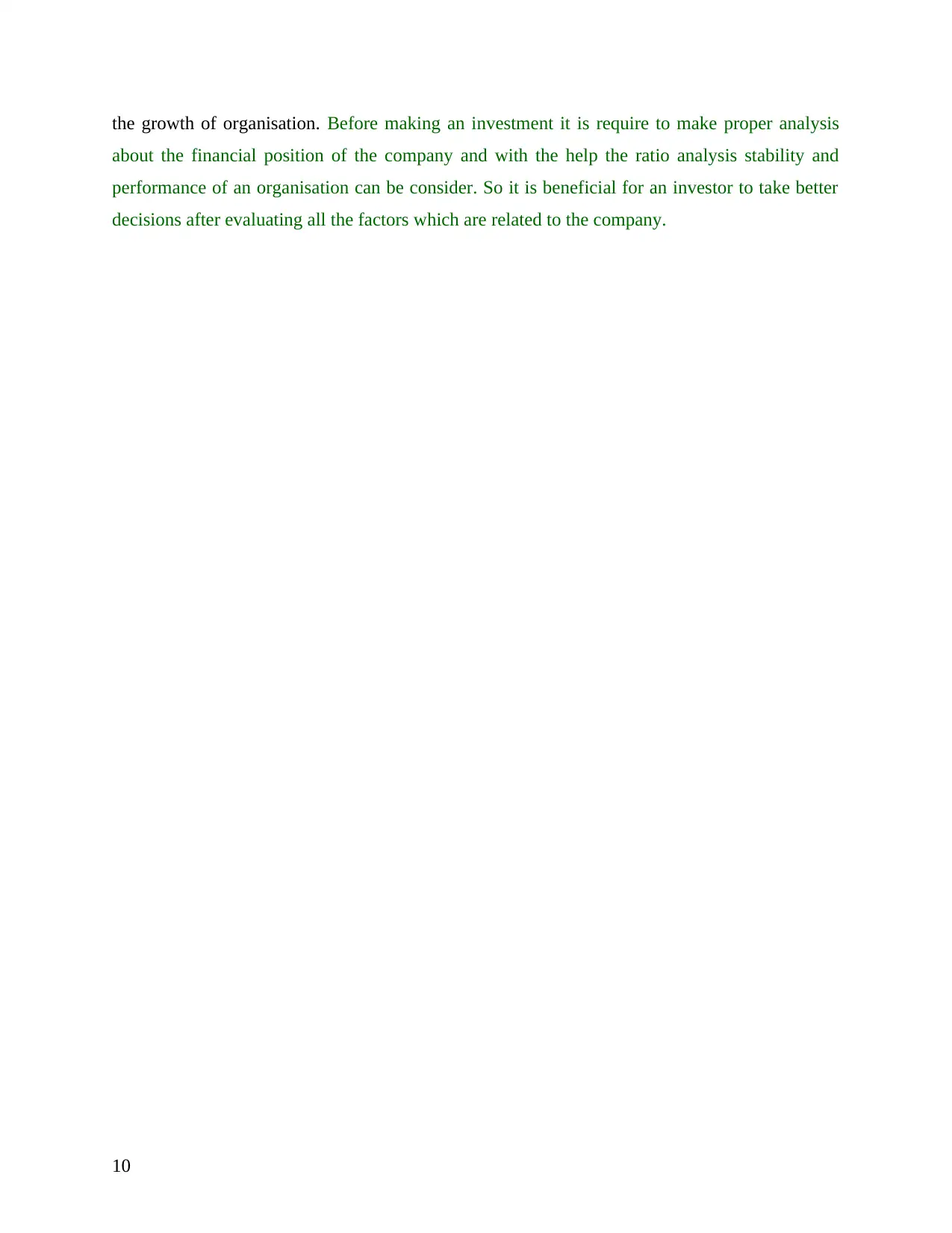
the growth of organisation. Before making an investment it is require to make proper analysis
about the financial position of the company and with the help the ratio analysis stability and
performance of an organisation can be consider. So it is beneficial for an investor to take better
decisions after evaluating all the factors which are related to the company.
10
about the financial position of the company and with the help the ratio analysis stability and
performance of an organisation can be consider. So it is beneficial for an investor to take better
decisions after evaluating all the factors which are related to the company.
10
Paraphrase This Document
Need a fresh take? Get an instant paraphrase of this document with our AI Paraphraser
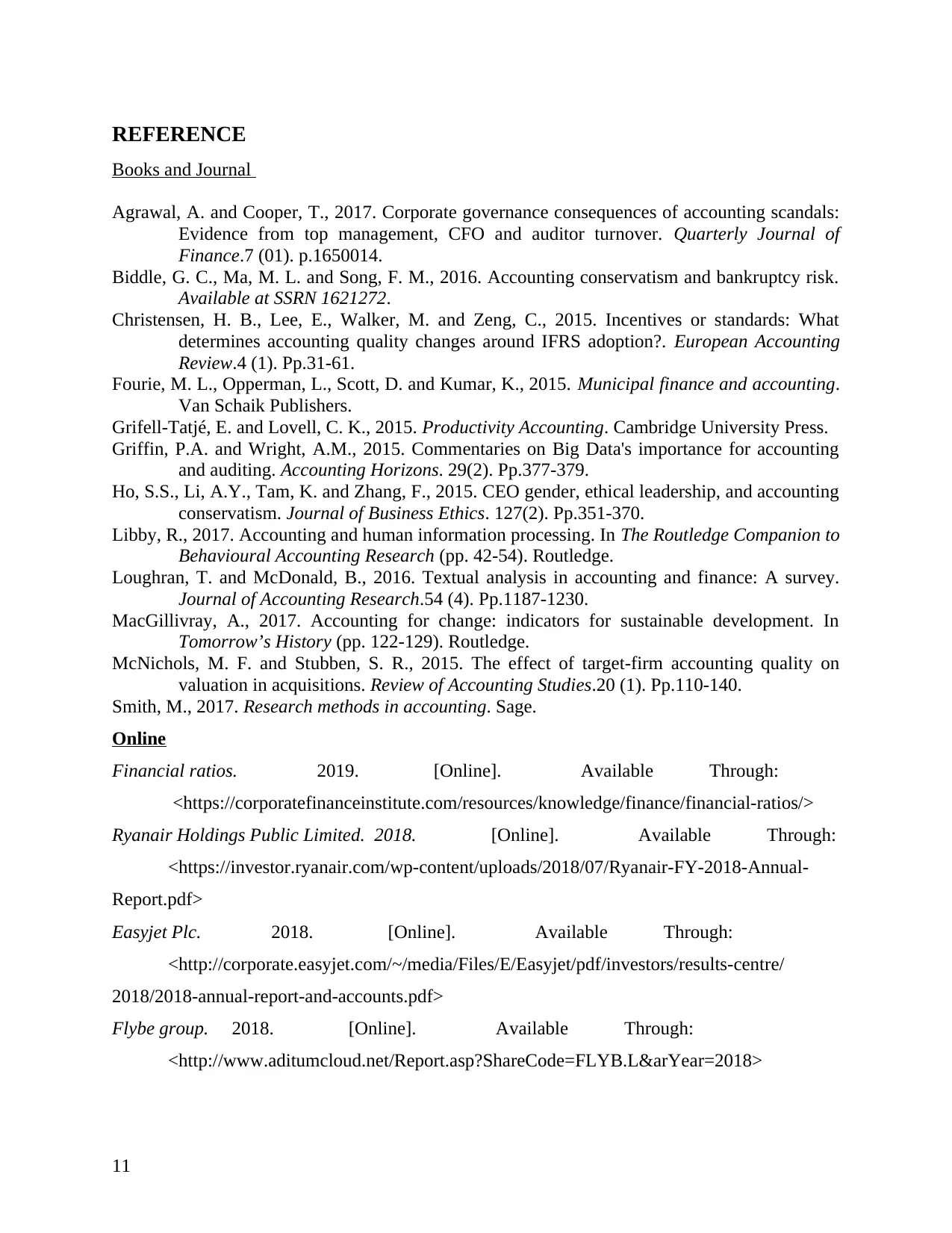
REFERENCE
Books and Journal
Agrawal, A. and Cooper, T., 2017. Corporate governance consequences of accounting scandals:
Evidence from top management, CFO and auditor turnover. Quarterly Journal of
Finance.7 (01). p.1650014.
Biddle, G. C., Ma, M. L. and Song, F. M., 2016. Accounting conservatism and bankruptcy risk.
Available at SSRN 1621272.
Christensen, H. B., Lee, E., Walker, M. and Zeng, C., 2015. Incentives or standards: What
determines accounting quality changes around IFRS adoption?. European Accounting
Review.4 (1). Pp.31-61.
Fourie, M. L., Opperman, L., Scott, D. and Kumar, K., 2015. Municipal finance and accounting.
Van Schaik Publishers.
Grifell-Tatjé, E. and Lovell, C. K., 2015. Productivity Accounting. Cambridge University Press.
Griffin, P.A. and Wright, A.M., 2015. Commentaries on Big Data's importance for accounting
and auditing. Accounting Horizons. 29(2). Pp.377-379.
Ho, S.S., Li, A.Y., Tam, K. and Zhang, F., 2015. CEO gender, ethical leadership, and accounting
conservatism. Journal of Business Ethics. 127(2). Pp.351-370.
Libby, R., 2017. Accounting and human information processing. In The Routledge Companion to
Behavioural Accounting Research (pp. 42-54). Routledge.
Loughran, T. and McDonald, B., 2016. Textual analysis in accounting and finance: A survey.
Journal of Accounting Research.54 (4). Pp.1187-1230.
MacGillivray, A., 2017. Accounting for change: indicators for sustainable development. In
Tomorrow’s History (pp. 122-129). Routledge.
McNichols, M. F. and Stubben, S. R., 2015. The effect of target-firm accounting quality on
valuation in acquisitions. Review of Accounting Studies.20 (1). Pp.110-140.
Smith, M., 2017. Research methods in accounting. Sage.
Online
Financial ratios. 2019. [Online]. Available Through:
<https://corporatefinanceinstitute.com/resources/knowledge/finance/financial-ratios/>
Ryanair Holdings Public Limited. 2018. [Online]. Available Through:
<https://investor.ryanair.com/wp-content/uploads/2018/07/Ryanair-FY-2018-Annual-
Report.pdf>
Easyjet Plc. 2018. [Online]. Available Through:
<http://corporate.easyjet.com/~/media/Files/E/Easyjet/pdf/investors/results-centre/
2018/2018-annual-report-and-accounts.pdf>
Flybe group. 2018. [Online]. Available Through:
<http://www.aditumcloud.net/Report.asp?ShareCode=FLYB.L&arYear=2018>
11
Books and Journal
Agrawal, A. and Cooper, T., 2017. Corporate governance consequences of accounting scandals:
Evidence from top management, CFO and auditor turnover. Quarterly Journal of
Finance.7 (01). p.1650014.
Biddle, G. C., Ma, M. L. and Song, F. M., 2016. Accounting conservatism and bankruptcy risk.
Available at SSRN 1621272.
Christensen, H. B., Lee, E., Walker, M. and Zeng, C., 2015. Incentives or standards: What
determines accounting quality changes around IFRS adoption?. European Accounting
Review.4 (1). Pp.31-61.
Fourie, M. L., Opperman, L., Scott, D. and Kumar, K., 2015. Municipal finance and accounting.
Van Schaik Publishers.
Grifell-Tatjé, E. and Lovell, C. K., 2015. Productivity Accounting. Cambridge University Press.
Griffin, P.A. and Wright, A.M., 2015. Commentaries on Big Data's importance for accounting
and auditing. Accounting Horizons. 29(2). Pp.377-379.
Ho, S.S., Li, A.Y., Tam, K. and Zhang, F., 2015. CEO gender, ethical leadership, and accounting
conservatism. Journal of Business Ethics. 127(2). Pp.351-370.
Libby, R., 2017. Accounting and human information processing. In The Routledge Companion to
Behavioural Accounting Research (pp. 42-54). Routledge.
Loughran, T. and McDonald, B., 2016. Textual analysis in accounting and finance: A survey.
Journal of Accounting Research.54 (4). Pp.1187-1230.
MacGillivray, A., 2017. Accounting for change: indicators for sustainable development. In
Tomorrow’s History (pp. 122-129). Routledge.
McNichols, M. F. and Stubben, S. R., 2015. The effect of target-firm accounting quality on
valuation in acquisitions. Review of Accounting Studies.20 (1). Pp.110-140.
Smith, M., 2017. Research methods in accounting. Sage.
Online
Financial ratios. 2019. [Online]. Available Through:
<https://corporatefinanceinstitute.com/resources/knowledge/finance/financial-ratios/>
Ryanair Holdings Public Limited. 2018. [Online]. Available Through:
<https://investor.ryanair.com/wp-content/uploads/2018/07/Ryanair-FY-2018-Annual-
Report.pdf>
Easyjet Plc. 2018. [Online]. Available Through:
<http://corporate.easyjet.com/~/media/Files/E/Easyjet/pdf/investors/results-centre/
2018/2018-annual-report-and-accounts.pdf>
Flybe group. 2018. [Online]. Available Through:
<http://www.aditumcloud.net/Report.asp?ShareCode=FLYB.L&arYear=2018>
11

Investment appraisal. 2019. [Online]. Available Through:
<http://www.businessdictionary.com/definition/investment-appraisal.html>
Investment appraisal model. 2019. [Online]. Available Through:
<https://www.apm.org.uk/body-of-knowledge/delivery/financial-cost-management/
investment-appraisal/>
12
<http://www.businessdictionary.com/definition/investment-appraisal.html>
Investment appraisal model. 2019. [Online]. Available Through:
<https://www.apm.org.uk/body-of-knowledge/delivery/financial-cost-management/
investment-appraisal/>
12
⊘ This is a preview!⊘
Do you want full access?
Subscribe today to unlock all pages.

Trusted by 1+ million students worldwide
1 out of 12
Related Documents
Your All-in-One AI-Powered Toolkit for Academic Success.
+13062052269
info@desklib.com
Available 24*7 on WhatsApp / Email
![[object Object]](/_next/static/media/star-bottom.7253800d.svg)
Unlock your academic potential
© 2024 | Zucol Services PVT LTD | All rights reserved.




